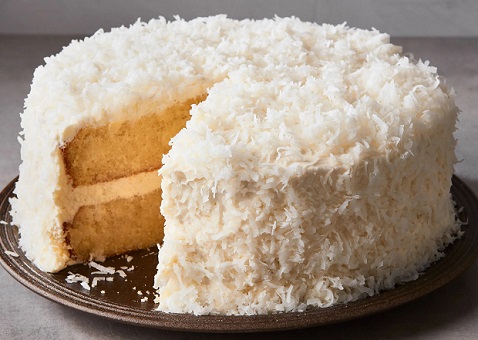Coconut Cake Recipe
Coconut Cake is a beloved dessert that brings a taste of the tropics to any occasion. This classic cake combines the rich, sweet flavor of coconut with a light, fluffy texture, creating a dessert that’s both indulgent and refreshing.
The origins of coconut cake can be traced back to the Southern United States, where it has been a staple at family gatherings, holidays, and special events for generations.
The allure of coconut cake lies in its versatility and the way it evokes memories of sunny beaches and tropical breezes.
The cake itself is typically a moist, tender vanilla sponge infused with coconut flavor, while the frosting is often a creamy, coconut-laden confection that adds both sweetness and texture.
The addition of shredded coconut to both the cake and its exterior not only enhances the flavor but also creates a visually striking dessert.
This recipe yields a traditional coconut cake that balances sweetness with the subtle, nutty flavor of coconut. Whether you’re baking for a special occasion or simply craving a slice of tropical paradise, this coconut cake is sure to impress with its delightful flavor and beautiful presentation.
Ingredients:
For the Cake:
- 3 cups (375g) all-purpose flour
- 2 teaspoons baking powder
- 1/2 teaspoon baking soda
- 1/2 teaspoon salt
- 1 cup (230g) unsalted butter, softened
- 2 cups (400g) granulated sugar
- 4 large eggs, room temperature
- 1 cup (240ml) coconut milk
- 1/4 cup (60ml) vegetable oil
- 2 teaspoons vanilla extract
- 1 teaspoon coconut extract
- 1 cup (85g) sweetened shredded coconut
For the Coconut Cream Cheese Frosting:
- 16 oz (450g) cream cheese, softened
- 1/2 cup (115g) unsalted butter, softened
- 4 cups (480g) powdered sugar
- 1/4 cup (60ml) coconut milk
- 1 teaspoon vanilla extract
- 1/2 teaspoon coconut extract
For Decoration:
- 2 cups (170g) sweetened shredded coconut, toasted
How to Make:
Prepare the Cake:
Preheat the oven to 350°F (175°C). Grease and flour three 9-inch round cake pans.
In a medium bowl, whisk together flour, baking powder, baking soda, and salt.
In a large bowl or stand mixer, cream butter and sugar until light and fluffy, about 3-4 minutes.
Add eggs one at a time, mixing well after each addition.
In a separate bowl, combine coconut milk, vegetable oil, vanilla extract, and coconut extract.
Alternately add the dry ingredients and the coconut milk mixture to the butter mixture, beginning and ending with the dry ingredients. Mix until just combined.
Fold in the shredded coconut.
Divide the batter evenly among the prepared pans.
Bake for 25-30 minutes, or until a toothpick inserted into the center comes out clean.
Allow cakes to cool in pans for 10 minutes, then turn out onto a wire rack to cool completely.
Make the Frosting:
In a large bowl or stand mixer, beat cream cheese and butter until smooth.
Gradually add powdered sugar, mixing until well combined.
Add coconut milk, vanilla extract, and coconut extract. Beat until smooth and creamy.
Assemble the Cake:
Place one cake layer on a serving plate. Spread with a layer of frosting.
Repeat with the second and third layers.
Frost the entire cake with the remaining frosting.
Decorate:
Press toasted shredded coconut onto the sides and top of the cake.
If desired, use additional frosting to pipe decorative borders or designs.
Chill the cake for at least 1 hour before serving to allow the frosting to set.
Chef’s Notes:
Coconut Milk: Use full-fat canned coconut milk for the best flavor and texture. Shake the can well before using.
Extracts: The combination of vanilla and coconut extracts provides a balanced flavor. If you prefer a stronger coconut taste, you can increase the coconut extract slightly.
Toasting Coconut: To toast the shredded coconut for decoration, spread it on a baking sheet and bake at 325°F (165°C) for 5-10 minutes, stirring occasionally, until golden brown. Watch it closely as it can burn quickly.
Room Temperature Ingredients: Ensure all refrigerated ingredients are at room temperature before starting. This helps create a smoother batter and frosting.
Cake Flour Substitution: For an even lighter texture, you can replace 2 tablespoons of all-purpose flour per cup with cornstarch to make cake flour.
Frosting Consistency: If the frosting is too thick, add a little more coconut milk. If it’s too thin, add more powdered sugar.
Make-Ahead Tips: The cake layers can be baked a day in advance, wrapped tightly in plastic wrap, and stored at room temperature. The frosting can also be made ahead and refrigerated. Bring to room temperature before using.
Storage: Store the frosted cake in the refrigerator, covered, for up to 5 days. Bring to room temperature before serving for the best flavor and texture.
Freezing: Unfrosted cake layers can be frozen for up to 2 months. Thaw overnight in the refrigerator before frosting.
Variations: Try adding a layer of lemon curd between the cake layers for a tangy contrast, or incorporate chopped macadamia nuts into the batter for added texture.
Nutritional Value:
Please note that these values are approximate and can vary based on specific ingredients and portion sizes. The following nutritional information is for one slice, assuming the cake is cut into 12 slices:
- Calories: 650-700
- Total Fat: 38-42g
- Saturated Fat: 25-28g
- Cholesterol: 120-130mg
- Sodium: 300-350mg
- Total Carbohydrates: 75-80g
- Dietary Fiber: 2-3g
- Sugars: 55-60g
- Protein: 7-8g
Coconut Cake is a rich, indulgent dessert and should be enjoyed in moderation as part of a balanced diet. However, it does offer some nutritional benefits:
Fiber: Coconut provides dietary fiber, which aids in digestion and helps maintain a feeling of fullness.
Minerals: Coconut contains small amounts of minerals such as iron, zinc, and manganese.
Medium-Chain Triglycerides (MCTs): Coconut oil, present in small amounts, contains MCTs which are easily digestible fats.
Energy: The high carbohydrate and fat content provide quick energy.
Despite these benefits, the cake is high in sugar and saturated fat, so it’s best enjoyed as an occasional treat.
Conclusion:
Coconut Cake is more than just a dessert; it’s a celebration of tropical flavors and textures that can transport you to a sun-soaked paradise with every bite.
This classic cake has been a favorite for generations, gracing tables at everything from casual family gatherings to elegant weddings.
Its enduring popularity is a testament to the universal appeal of its sweet, nutty flavor and soft, moist texture.
The process of making a Coconut Cake from scratch is a rewarding experience that engages all the senses. From the sweet aroma of coconut that fills your kitchen as the cake bakes to the satisfying texture of pressing toasted coconut flakes onto the frosted surface, each step is an opportunity to connect with the rich culinary tradition behind this beloved dessert.
While Coconut Cake is undoubtedly an indulgence from a nutritional standpoint, it’s important to remember that food is not just about sustenance—it’s also about pleasure, celebration, and cultural connection.
The joy of sharing this delightful cake with friends and family, the way it can elevate a simple gathering into a special occasion, has a value that goes beyond mere calories and nutrients.
For those mindful of their dietary intake, Coconut Cake can still be part of a balanced lifestyle when enjoyed in moderation. Its rich flavor means that even a small slice can be deeply satisfying.
Additionally, the recipe can be adapted to suit various dietary needs, such as using sugar alternatives or gluten-free flour, although these modifications may alter the traditional taste and texture.
In preparing and serving Coconut Cake, you’re not just creating a dessert—you’re participating in a culinary tradition that spans generations and crosses cultural boundaries.
Whether you’re an experienced baker or trying your hand at this recipe for the first time, the process of creating this iconic cake is an adventure in itself.
The combination of tender cake, creamy frosting, and the distinctive texture of coconut creates a symphony of flavors and sensations that continues to delight dessert lovers of all ages.
So, preheat your oven, gather your ingredients, and embark on the delightful journey of creating your own Coconut Cake.
Whether it’s for a birthday, a holiday celebration, or simply to bring a touch of the tropics to an ordinary day, this cake is sure to become a cherished addition to your baking repertoire.
With its snowy white appearance and irresistible coconut flavor, it’s a dessert that not only satisfies the palate but also brings a sense of joy and occasion to any table it graces.
Thanks for visiting Birthday Cakes Recipe

